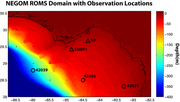
"...the sea is a continual miracle. The fishes that swim...
the rocks... the motion of the waves..."
the rocks... the motion of the waves..."
- Walt Whitman
Circulation dynamics and larval transport mechanisms in the Florida Big Bend region
The Big Bend region (BBR) in the northeastern Gulf of Mexico (NEGOM) conatins some of the country's most ecologically diverse and economically productive marine habitats in the United States.
This region contains both spawning sites and nursery habitats for many key species of the region. Considerable pressure from fishing in the Gulf has motivated the need for accurate prediction of
the year-class strength of threatened species. One such species is the gag grouper (Mycteroperca microlepis)
click images to enlarge
This study uses the gag grouper as a representative for the plethora of reef fish species in the BBR, due to its economic importance as a top-level
predator and the scarce knowledge of its eary life stages. Adult gag spawn on offshore reefs along the continental shelf break each Spring (Feb - April)
(Coleman et al., 1996). During their pelagic stage, gag larvae are transported
across the shelf until eventually settling as juveniles in the seagrasses of the coastal BBR waters 30-60 days later
(Koenig and Coleman, 1998).
However, while decades of ichthyoplankton surveys in the NEGOM have found Serranidae to be one of the most abundant families taken, the subfamily
Epinephelinae have not been among those found (Keener et al., 1998).
The physical mechanisms responsible for transporting these larvae remain unkown.
Technical Approach
The role of upwelling dynamics and Ekman transport in distributing passive particles into near-coastal waters are assessed in this study.
The main tool that will be used is a very high-resolution numerical ocean model. The Regional Ocean Modeling System (ROMS),
configured at 1/120°, is nested one-way within the Gulf of Mexico HYCOM (www.hycom.org) . The domain extends north of 28°N and to the east of 86.75°W, a region that encompasses the entire BBR and the
local shelf break. Simulations are run for 2004-2010, corresponding with a period of gag sampling efforts in the BBR. Using output from the physical model, we simulate
the motion of particles within the local shelf circulation using a Lagrangian particle tracking model (LTRANS). Behavioral patterns are then included into the particle tracking algorithm, allowing
the simulated particles to be used as proxies for gag larvae.
NOTE: Images, movies, and information displayed on this page are preliminary and experimental. They should not be used for any purposes other than education.
Sea surface temperatures (C) and surface currents for the Northeastern Gulf of Mexico. The dark black line represents the the outer boundary of the NEGOM ROMS modeling domain, while
fields to the exterior of the line are those provided by the Gulf of Mexico HYCOM. The movie demonstrates the smooth transition between the nested regional model and the external model.
Passive particles advected in the 2006 BBROMS circulation. Particles are seeded 0.5 below the surface between 50-100m isobaths at 3-hourly intervals for 12 weeks (starting 01 Feb).
Particles are colored by their depth at each time step. See full size at
http://vimeo.com/austinctodd

